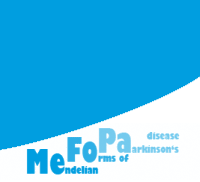PROJECT
Concept
Mendelian forms of Parkinson’s Disease (PD) are a group of rare diseases which recapitulate many of the clinical, pathological and biochemical features of the common sporadic form of the disorder, and are therefore seen as model diseases which allow to study the underlying pathogenic molecular mechanisms and pathways. It is the understanding of PD pathways that is the prerequisite for the development of novel disease modifying and neuroprotective treatments. It is likely that those treatments will benefit all PD patients, as it becomes increasingly clear that the gene products and their interaction partners identified in rare Mendelian variants also play a crucial role in the sporadic disease.
Mendelian forms of PD can be divided into two groups: autosomal-dominant forms caused by mutations in the genes for a-synuclein (SNCA) and for leucine rich repeat kinase 2 (LRRK2), and autosomal-recessive forms caused by mutations in the genes for parkin (PRKN), Pten-induced kinase-1 (PINK-1), and the oncogene DJ1.
The mutations in the dominant genes are thought to cause PD by a gain-of-function mechanism. SNCA- as well as most cases of LRRK2-related PD are pathologically characterized by aggregates of a-synuclein (“Lewy-pathology”). It is therefore appropriate to assume that the pathogenic mechanisms of SNCA- and LRRK2-related PD interconnect. Research on the pathogenesis of those forms of Mendelian PD is coordinated in subproject 1.
Autosomal-recessive mutations in the genes for parkin, PINK-1 and DJ1 are believed to exert their pathogenic effect due to loss of some essential protective function. There is converging evidence suggesting that dysfunction of all recessive PD genes contribute to a state of increased cellular stress due to mitochondrial dysfunction and increased burden of radical oxygen species (ROS) and that at least two of the recessive PD genes, parkin and PINK1, operate within one single pathway. The molecular underpinnings of recessive forms of Mendelian PD will therefore also be investigated together, in subproject 2.
The findings in the basic science work-packages of the first two subprojects will directly feed into subproject 3, where a European registry and biobank for patients with rare Mendelian forms of PD will be established in order to advance investigations of biomarkers.
